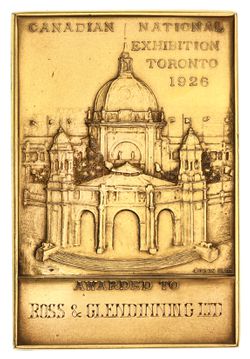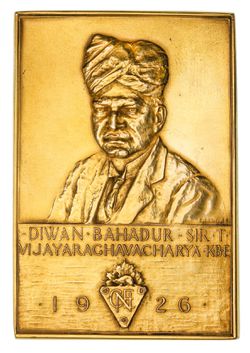Commemorative & Historical Medals 1906-1935
Lot 681 SESSION 2 (11.30AM MONDAY 11TH SEPTEMBER) Commemorative & Historical Medals 1906-1935
Estimate $5,000
Bid at live.noble.com.au
SOLD $3,800
CANADA, Canadian National Exhibition Toronto, 1926, medal struck in gold (14ct [tested] 84.0g, 64x43x4mm), by Roden Bros (Toronto), inscribed on obverse, 'Ross & Glendinning (sic) Ltd', reverse with portrait of Diwan Bahadur - Sir T.Vijayaraghavacharya KBE. Some scratch test marks, otherwise extremely fine and very rare.
Together with gilt desk stand.
When Scottish immigrants John Ross and Robert Glendining took over a retail drapery business in Dunedin in August 1862, they began a partnership that led to one of the great manufacturing stories of the Otago region.
After three years, they turned their business, Ross & Glendining, into a wholesale operation. The move from being drapers and outfitters to importers and warehousemen began when they opened their new warehouse at 28 Stafford St in Dunedin.
Ross & Glendining imported a range of goods from Europe to supply the growing populations of Canterbury and Otago. The business grew to employ 'travellers' to sell to retailers all over New Zealand, including on the Otago goldfields. This included fashion items such as kid gloves and those made from silk and satin. But the most popular items purchased from Ross & Glendining at this time were blankets, hosiery, flannels and moleskin trousers (Doing Well and Doing Good by SRH Jones).
John Ross relocated to London in 1870 to run the firm's London buying office, leaving Robert Glendining to run the day-to-day business in New Zealand. Over the next few decades the business expanded to include sheep farming, milling and manufacturing.
Up until the 1870s, the bulk of the clothing in New Zealand was either imported, made to measure by tailors and dressmakers, produced by large retailers or made at home. The introduction of the sewing machine made it possible to mass-produce clothing. One of the first to do so was Isaac Hallenstein & Co, also Dunedin-based. At this time, Ross & Glendining decided it made more sense for them to buy rather than manufacture.
To secure an alternative source of woollen cloth, Ross & Glendining built the Roslyn Woollen Mill in 1879. Located in the Kaikorai Valley in Dunedin, the mill was designed to produce a mixture of yarn, blankets, flannels and plaiding. Several years later, new knitting machines were installed to manufacture hosiery and knitwear. Roslyn Mill was also the first mill in the Southern hemisphere to produce worsted.
In 1883 Ross & Glendining opened their own clothing factory opposite the Stafford St warehouse. They were facing falling sales of their imported goods (Doing Well and Doing Good). Most of the cloth came from the Roslyn Mill, while trimmings, buttons and thread were usually bought by John Ross in London. The factory made men's and boys' clothing, which was marketed under the Roslyn brand.
Almost two decades later there were more than 500 people working at the Roslyn Mill. They used wool from the Ross & Glendining sheep farms to manufacture a range of woollen garments, including felt boots and shoes, hosiery, bathing suits, hats and coats. John Ross frequently returned to New Zealand but during one trip in 1899 he was "shocked by the intemperate habits of Glendining and his son" (Doing Well and Doing Good). He initiated the conversion of the partnership to a limited liability company, which meant that the business would continue in the case of the death of one or both of the partners. The majority of the shares were held by Robert and John, with the rest divided up between their families and senior managers in New Zealand and London.
By 1905 John Ross had returned to New Zealand permanently. He was closely involved in the company until the 1920s, when a new management team led by his son took over.
The company continued to expand manufacturing during the first half of the 20th century. Factories in Dunedin, Invercargill, Christchurch, Te Awamutu, Auckland and Whangarei manufactured a wide range of clothing and shoes under a number of labels including Fleur Fashions, Plunket Flannel, Clifton Knitwear, Hi-Fi and Sportscraft. They also manufactured British and American labels under license, such as Anthony Squire Suits, Town Talk ties, Osti lingerie and Sacony Fashions.
By the 1960s, however, share prices were falling. The board restructured the company and, in response to the growing Auckland market, they moved the Ross & Glendining head office to Auckland. The majority of the warehouses and a number of factories were closed. The sharemarket was "not impressed" by these activities (Doing Well and Doing Good, page 355). In 1966, Ross & Glendining was acquired by the United Empire Box group of companies. The century-old business was broken up and its assets were sold. Mosgiel Woollens Ltd bought the Roslyn Mill from UEB but the reprieve was only temporary. Roslyn closed in 1980 after Mosgiel went into receivership.
The names Ross and Glendining live on in two Dunedin streets - Ross St and Glendining Ave and in the Ross Home for the elderly. The Stafford St factory has avoided demolition. It stands, empty and silent these days, still bearing the names of its founders.
Courtesy: New Zealand Fashion Museum and Kelly Dix, Museum of New Zealand Te Papa Tongarewa, Wellington.
The following courtesy of Wikipedia - The Free Encyclopedia:
Diwan Bahadur Sir Thiruvalayangudi Vijayaraghavacharya KBE (27 August 1875 - 28 February 1953) was an Indian civil servant and administrator who served as the Diwan of Cochin kingdom from 1919 to 1922. Vijayaraghavacharya was also a member of the Constituent Assembly of India representing Udaipur.
Vijayaraghavacharya was born in Erode on 27 August 1875 and was educated at the Presidency College, Madras. Vijayaraghavacharya completed his B. A. in 1894 and obtained an M. A. in 1898.
Vijayaraghavacharya joined the provincial civil service in 1898 and served, initially, as a district officer. From 1912 to 1917, he served as Secretary in the Board of Revenue, Madras Corporation and as Deputy Director of Industries from 1918 to 1919. In 1919, he was appointed Diwan of the Cochin kingdom and served from 1919 to 1922.
During his tenure, Vijayaraghavacharya started the industrialization of Cochin kingdom. The Nair Regulation was introduced in 1920. Female literacy increased considerably during this period. Local Self-governing bodies such as village panchayats and municipal councils were given increased powers and privileges.
In 1922, he was appointed Commissioner for India at the British Empire Exhibition, Wembley and was, in 1926, made Director of Industries. He also served for a short time as member of the Public Service Commission and in 1929, was appointed Vice-Chairman of the Imperial Council for Agricultural Research.
He officiated at the opening of the Canadian National Exhibition, Toronto in 1926.
Vijayaraghavacharya retired from the civil service on 25 December 1935. Four years later, he was appointed Diwan of Udaipur.
Vijayaraghavacharya died on 28 February 1953 at the age of 77.
Estimate / sale price does not include buyer's premium (currently 22% including GST) which is added to hammer price. All bids are executed on the understanding that the Terms & Conditions of sale have been read and accepted. For information on grading and estimates please refer to the Buying at Auction advice.
Quick find
View a lot by number and sale.
Adjacent lots
Lot 679
SOUVENIR WALL PLAQUE, Dunedin Exhibition, 1925-26, in alabaster (125x90mm) with bronze exhibition scene inset, with ...
Estimate $200
Lot 680
DUNEDIN EXHIBITION, 1925-26, brass plate (80x60mm), scene of main building. Toned, fine.
Estimate $80
Lot 681 This lot
CANADA, Canadian National Exhibition Toronto, 1926, medal struck in gold (14ct [tested] 84.0g, 64x43x4mm), by ...
Estimate $5,000
Lot 682
THE VISIT OF THE MAORI RUGBY FOOTBALL TEAM TO GREAT BRITAIN, 1926-27, struck in silver ...
Estimate $1,500
Lot 683
N.Z., Thames Jubilee, 1927, struck in silver (35x9mm), no maker, pin-back (M.-). Very fine and ...
Estimate $350

